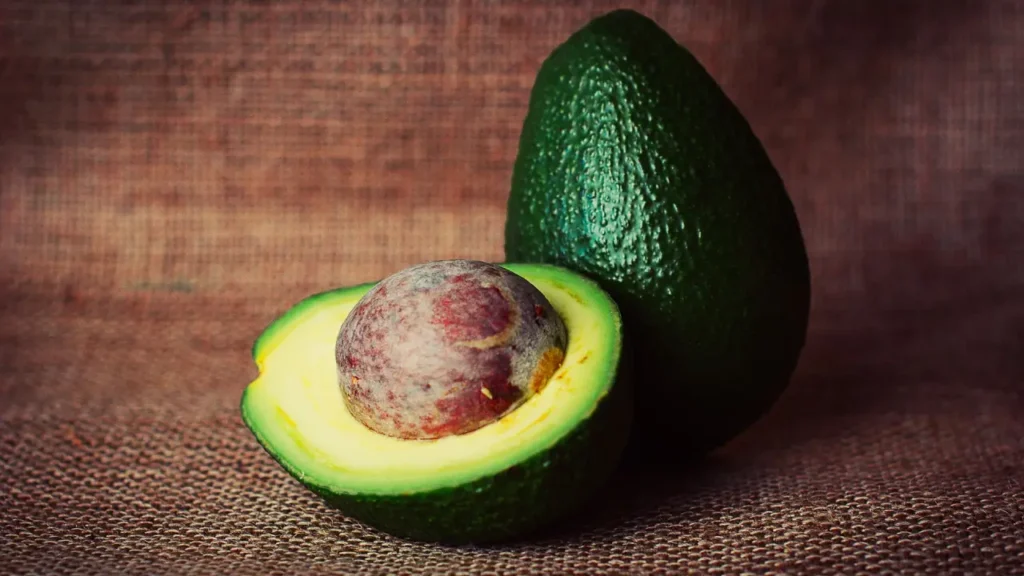Raspberry plants are delightful to cultivate, and the fruit makes your garden a lot more delicious too. Bright reds and yellows of ripe fruits lying sun shining over the shrubs that carry big juicy berries that can be harvested and their sweet smell is so appealing. An enjoyment is produced with every bite and which creates flashes of happiness. So if you are not sure how to grow raspberries, you have nothing to worry about as we are going to lead you on how to do it. This is why many people, including the novices, should consider growing it with a few tips and care because it will make your garden colourful and productive at the same time.
Not only is it makes the garden and its produce look beautiful, but one is able to harvest the fruits directly. It is important to have some guideline that can lead any newbie into growing raspberries successfully.
Key Takeaways
- Plant raspberries in early spring once soil temperatures reach 50°F.
- Ensure proper spacing of 18-24 inches for different raspberry varieties.
- Water regularly, maintaining moisture for optimal growth.
- Support raspberry plants with a T-trellis for better development.
- Prune effectively to enhance yields and maintain healthy growth.
- Raspberries require 6-8 hours of sunlight each day for best results.
- Using organic mulch helps control weeds and retain soil moisture.
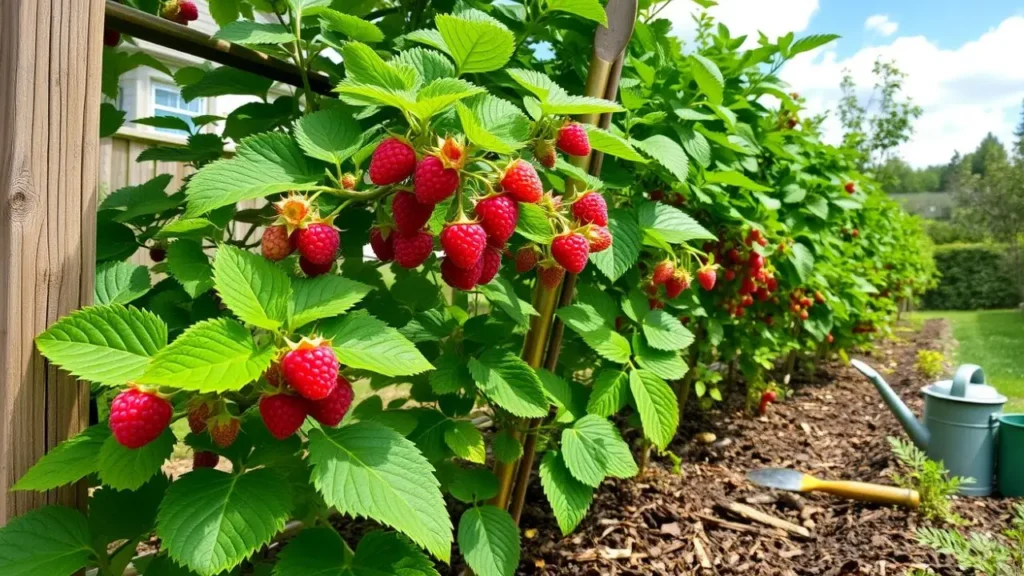
Table of Contents
Introduction to Growing Raspberries
Raspberries are among the most preferred fruits in North America thanks to their taste besides being healthy fruits. All these plants are cultivated in USDA Hardiness Zones 3 – 10 thus making it easier for many people to cultivate them. If you want to plant raspberries, it’s critical for you to understand what the plant requires to live for years.
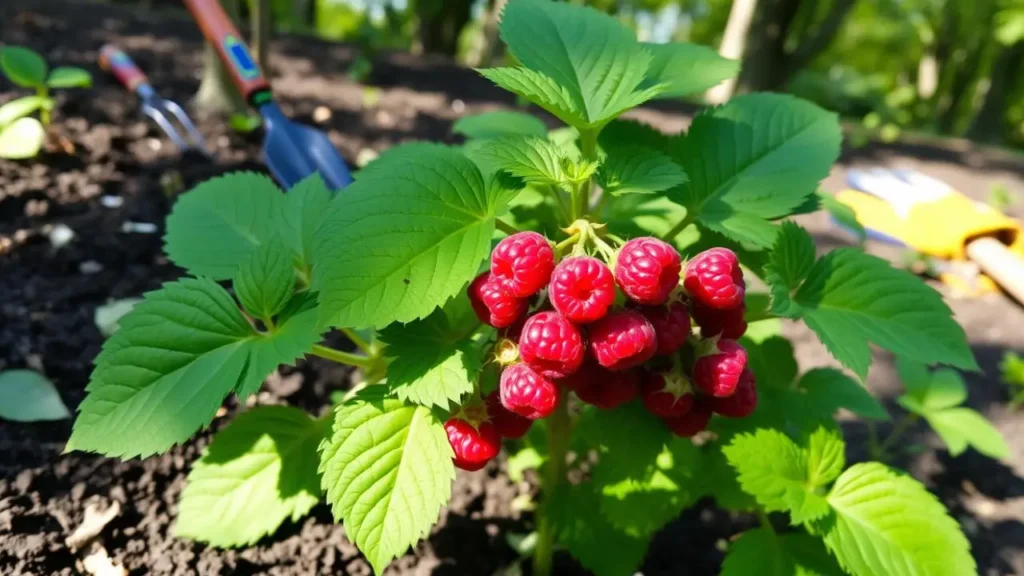
Raspberries love full sun. They must be offered six to eight hours of sunlight a day. A little kind of raised bed that is around 20 inch in height facilitates drainage and disease prevention.
There is much that has to be put into consideration when planting raspberries. An ideal size is a two-row patch, 7ft wide by 33 ft long. This creates sufficient space for growth and Air. The soil must be correctly drained and slightly acidic with pH ranging from 6.0. For plants to grow up to between 6 to 7 feet tall they require enough Nitrogen.
Some practices involved in raspberry gardening include; pruning and pest control. Difference between the summer and fall-bearing helps in taking care of the plant which is important for its growth. If properly taken cared of, gardeners are able to enjoy their raspberry plants for many years now.
Understanding Raspberry Varieties
To start the raspberry garden it requires selecting the right raspberry varieties that are ideal for home gardening. This means that a distinction between the summer-fruiting and the ever-bearing raspberries is important. Both types have their benefits depending on the personality of gardening and the climatic conditions.
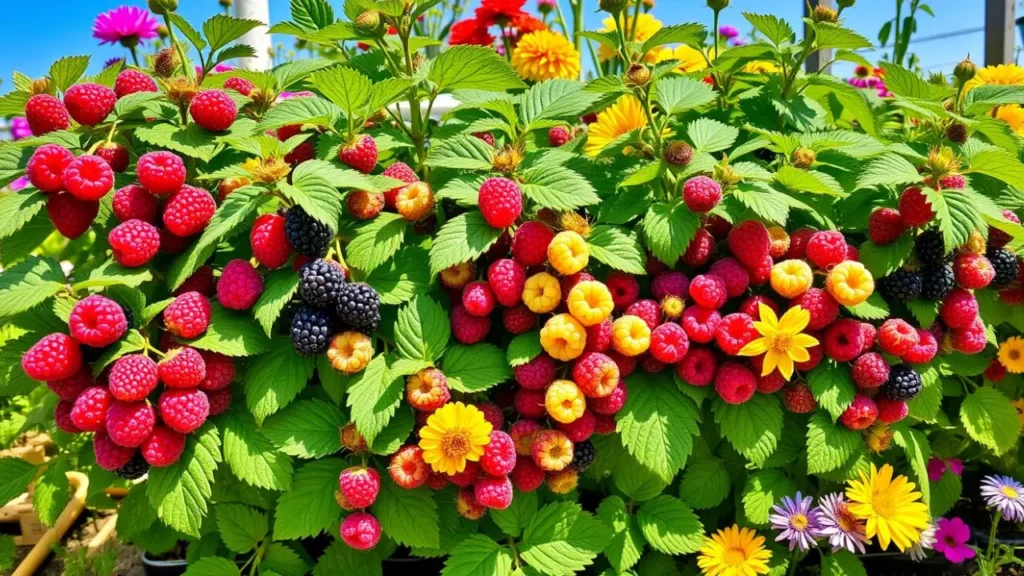
Summer-Fruiting vs. Ever-Bearing Varieties
Summer-fruiting raspberries produce fruit only once a year and it is in the months of June and July. It can stem rather high, above 1. 8 meters (6 feet). Ever-bearing raspberries, do give two crops on the other hand. They have what is called early yield or first yield in June and July and the later yield which begins in early August and continues until the first frost.
Choosing the Best Varieties for Your Garden
Picking the right varieties is crucial for a good harvest. Here are some top picks:
| Type | Varieties | Characteristics |
|---|---|---|
| Summer-Fruiting | Canby, Heritage | High yield and robust growth, ideal for mid- to cooler climates |
| Ever-Bearing | Fallgold | Golden berries with a rich flavor, suitable for warmer regions |
It’s important to look at certain factors such as the climate and type of soil that is present in your region when selecting raspberries. Some varieties in that respect are better than others, which has implications on the growth and progress of varieties. It also provides an understanding of summer-fruiting and ever-bearing raspberries so that one can successfully plant the berries garden.
How to Grow Raspberries: Selecting the Right Location
When planning with intention to cultivate raspberry, one ought to also consider where to put them. Plant location is vital for growth, and more especially for abundant production of fruits. Raspberries love the sun and as with most fruits they should be grown in good soil.
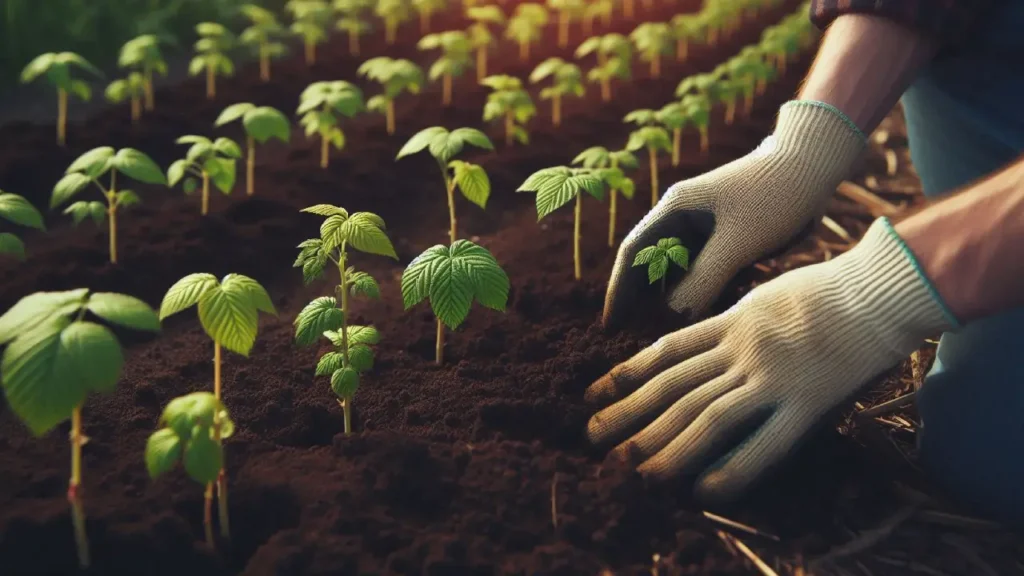
Sunlight and Soil Requirements
Raspberry bushes require sunlight for 6 to 8 hours per day. They need it in order to grow and to set fruit. The soil must be fertile and capable of holding the right amount of water.
Also, the spacing that is associated with planting the seed determines how it will be done. The red and yellow raspberries should be planted between 2 – 3 feet apart. Black and purple ones require minimum of 4 feet so that they may receive adequate sun and nutrients.
Avoiding Pests and Diseases
It is important to protect raspberries from pests and diseases in order not to affect the plants. Ensure they breath sufficient air not to be prone to diseases. Also, keep them away from wild berry bushes as the latter harbors one pest or the other.
Black raspberries should be planted at about 75 to 100 feet of the distance from other types of raspberries. This is useful in avoiding contraction of the viral diseases in the various affected areas. By doing so, your raspberries will germinate properly and grow effectively.
Preparing Your Soil
The importance of getting the soil type right can not be overemphasized in order to grow raspberries. These include the type of soil that is suitable for the growth of raspberries and many quantities of them produced. It is true that raspberries’ prospects relate to the employing of good soil techniques to the soil to enhance the yield of raspberries.
Soil Improvement Techniques
Improving raspberry soil needs focus. Here are some ways to make your soil better:
- Mix in compost, grass clippings, and shredded leaves to add nutrients.
- Use dehydrated cow manure to increase nutrient levels.
- Add garden lime to adjust the soil’s pH, aiming for 5.6 to 6.2 for raspberries.
- Use mulch to keep moisture in, fight weeds, and improve soil over time.
- Test your soil often to see what it needs and keep nutrients balanced.
Creating a Well-Drained Planting Area
Pine barrens, raspberries and brambles require proper drainage for the proper growth of the raspberry bushes. It prevents roots from rotting as well as disease control. Here’s how to make sure your area drains well:
- Choose a spot that gets 6 to 8 hours of sun a day.
- Use loamy soil for its good moisture and drainage.
- If your soil is clay or silt, add sand to help it drain better.
- Dig a deep trench for the roots to grow, helping the plants thrive.
- Plant raspberries 30-40 cm apart and rows 180 cm apart for air and sun.
| Soil Type | Moisture Retention | Drainage Capability |
|---|---|---|
| Loamy | Good | Excellent |
| Clay | High | Poor |
| Sandy | Low | Good |
| Silt | Moderate | Poor |
Planting Raspberries: Step-by-Step Process
Growing raspberries requires some form of time and method in order to have healthy plants and wonderful yields. The general knowledge about when and how to plant raspberries can be of great influence when one is gardening. Below are the various steps on how best to plant raspberries.
When to Plant Raspberry Canes
There are many good tips to planting raspberry canes, but probably the two best times to do this are at the beginning of spring or at the end of autumn. This is particularly the case in the regions that do not experience very harsh winter or summer season. Sowing of crops during these times allow for the roots of the crops to develop well before the unfavourable climatic conditions arrive. It guarantees the intensive growth when the climate becomes warmer.
How to Plant Raspberries Correctly
Proper planting is key for strong raspberry plants. Here’s how to do it right:
- Presoak the roots of the raspberry canes so that they can be soaked for a few hours in water before planting is done.
- Mounds furrows that should accommodate the roots and this space would be 12 inches wide and 12 inches deep.
- Now put the cane in the hole erecting the crown part of the plant above the ground. Bury the roots of the plant up to about 2 inches deep into the soil.
- Seating distance of the space canes should be 45cm and rows, 1.8 m apart especially with consideration being given to the number of learners and to provide adequate light and air.
The use for these methods assists in making the area for the raspberry patch to be healthy. It also guarantees that your plants will be healthy for several years. The overall process of planting raspberries as explained in the mentioned steps results in several yields in the future.
| Step | Action |
|---|---|
| 1 | Soak roots in water. |
| 2 | Digs holes (12 inches wide & deep). |
| 3 | Place canes with crown above soil. |
| 4 | Cover roots with ~5cm of soil. |
| 5 | Space canes 45cm apart, 1.8m between rows. |
Raspberry Plant Care and Maintenance
Raspberry plant requires special attention in order for them to grow well. They have to be watered right and mulched appropriately to support this growth of the plant. By following these it builds them strong to fruit well.
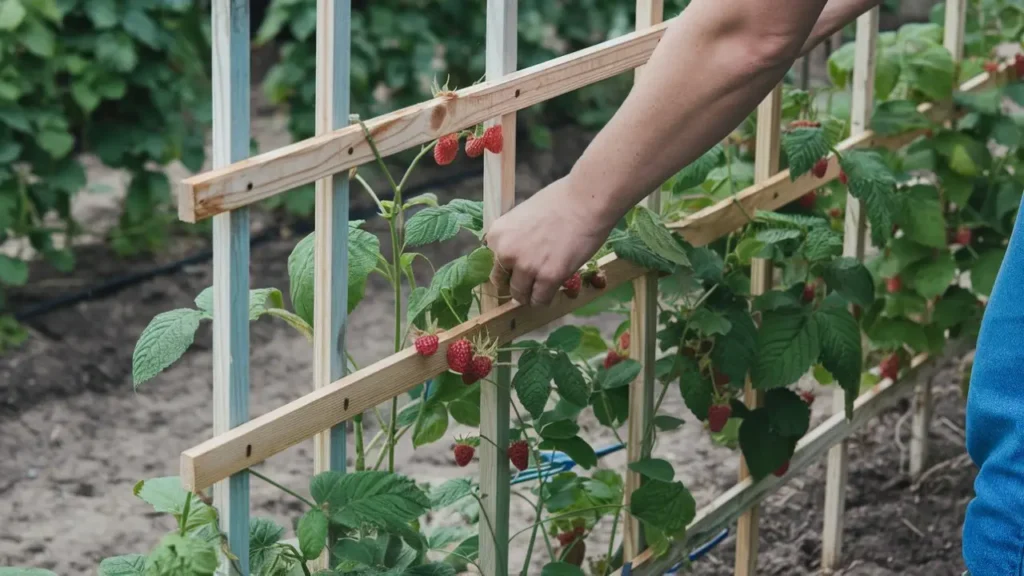
Watering Techniques for Optimal Growth
Raspberry plant require moderate water irrigation for it to grow to its optimum potential. They should be given about 1 inch of water per week preferably at one go. It is preferable so that they are watered through drip irrigation.
This method deliver water directly to the root part of the plant. It saves water and ensures that the soils are moist most of the time. It also prohibits the leaves from coming into contact with water especially in the morning dew which can be disastrous to the leaves since it spreads diseases.
Such operations as deep watering are crucial, because they enable the roots of the plant to develop. Thus, do not fail to water the soil whenever it is dry; else the seeds may fail to germinate or may even die.
Importance of Mulching
Pruning however is very crucial when it comes to raspberry plants and mulching. It excludes weeds that also competitively demand foods and water on the ground. It is also known that mulch retain moisture and regulates temperature of the soil.
It safeguards the roots against extreme temperature either high or low. If one has to use the organic mulch then it must be straw, wood chipped or shredded leaves. Use it at a thickness of approximate to 2 and 4 inches for the best results to be achieved.
How to Cultivate Raspberries Effectively
Suckers require special care when growing raspberries. These new canes can lump from your fruit bearing canes and deprive them of nutrients. Practical raspberry sucker control maintains green and productive raspberry plants. Below are some useful guidelines for your raspberry plants to grow healthy or rather be healthy.
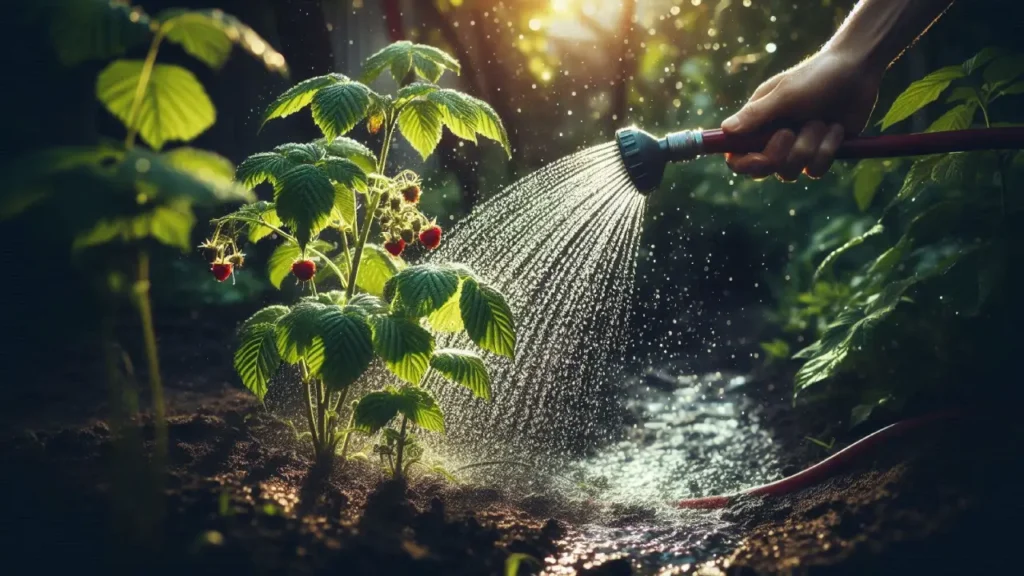
Managing Suckers and New Growth
Bearing and non-bearing suckers should, therefore, be effectively controlled to facilitate the growth of raspberries. Here are some important steps for effective sucker management:
- Regular Monitoring: See how many ‘fools’ increase in number. However, if there are too many they may just distract the attention away from the main plants.
- Selective Removal: Prune back on suckers so as to control them and enable the plant to concentrate on the fruit. Effective pruning also allows air to circulate and also helps to deter diseases.
- Replanting Suckers: Healthy suckers should uproot from the initial area and planted at a new area which possesses good soil.
- Spacing: Raspberry plants should be planted 3-4 feet apart to give them enough space for growth or to receive sunlight.
- Use of Support: Place T-posts every 5-8 ft to support the plant growth and as a wind break.
They all are important steps in maintaining healthy raspberry pads. They assist you get more fruit; at the same time the plants are not tipping to one side. Timely management helps to make your raspberries healthy and bearing fruit.
| Technique | Description |
|---|---|
| Regular Monitoring | Keep an eye on sucker growth for the best management. |
| Selective Removal | Take out too many suckers to help the fruit-bearing canes get more resources. |
| Replanting Suckers | Use healthy suckers by moving them to a new spot for more growth. |
| Appropriate Spacing | Let each bush get sunlight and water well. |
| Support Structures | Keep plants safe from wind and help with berry growth using T-posts. |
Using these methods will improve your raspberry growing. You’ll get great harvests every season.
Pruning Raspberries for Better Yields
Trimming is important to have optimal growth in raspberry plants as well as the production of more fruits. There are right techniques that need to be followed when pruning raspberries and it’s for this reason that one needs to be attentive. There are different types of raspberry and they require different pruning and at different time.
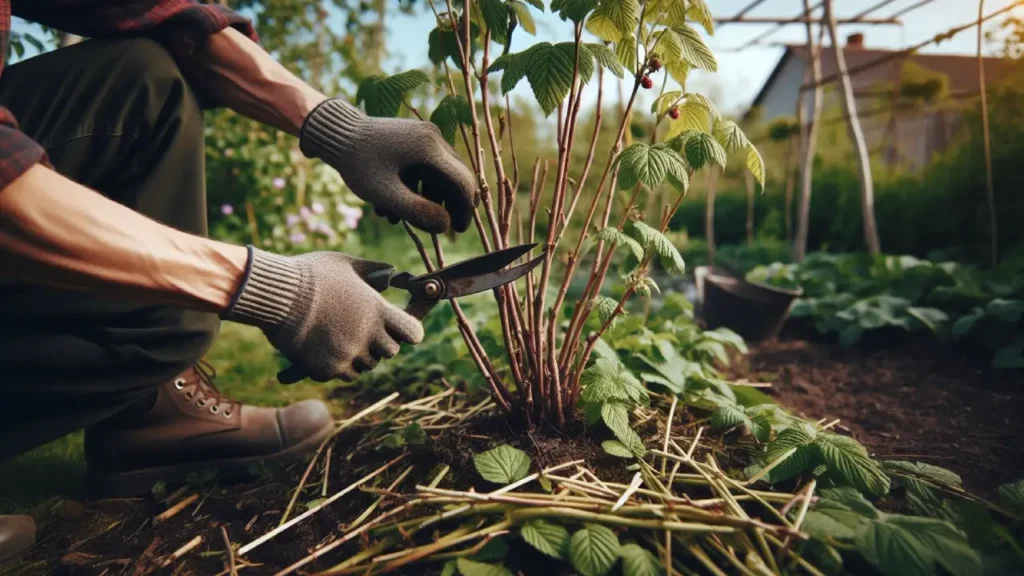
Pruning Techniques Based on Variety
Summer-bearing raspberries require proper pruning than ever bearing raspberry plants. They bear fruits on last year’s caned plants and partially on the current year canes albeit less commercial significance. These canes should be cut to the ground to produce new ones after picking is done on each of the bushes.
In contrast, the primocane-fruiting raspberries are easy to prune and require little efforts in pruning. They do not depend on the growth achieved in the previous year so if you wish, you can even trim them to the base.
Based on the above proper pruning of raspberry methods helps in maintaining healthy plants and also enhances the ease in picking of the fruits. Keeping canes upright the trellis wires can be tucked between them. Also, one should remove all the dead or damaged canes to ensure that the plant directs most of its energy towards the fruit.
Timing and Frequency of Pruning
The timing of pruning is extremely important if one is to get the best outcomes. Reduce fall-bearing types in late winter to better the forthcoming year’s yield. Summer bearing types should be pruned immediately after they are done with fruiting.
This time also allows the plant to do well and rest before the next season comes in.
Here’s a pruning schedule to follow:
- Summer-Bearing Varieties: Prune after fruiting, cutting away spent canes for new growth.
- Fall-Bearing Varieties: Prune in late winter, removing weak or diseased canes.
If you get into the habit of using these pruning methods then there will be more raspberries. Not only will your plants survive but indeed do very well.
Harvesting Raspberries: Best Practices
It is important to understand how to properly harvest raspberries to get the highest quality and taste of this fruit. But it is important to learn how to pick them properly in order to make the most out of the endeavor. This is true with picking as well because how we pick as well as how we store them after picking cannot be overlooked.

Proper Harvesting Techniques
There is nothing as crucial in raspberry picking than the time of the day when you have to make your harvest. Summer-bearing varieties are harvested a month after blooming has occurred. Ever-bearing types begin in mid summer and continue through frost. To ensure that they are ripe you have to look for berries that have shown readiness and can easily be pulled off the cane.
Carefully flex the raspberry from the cane without applying great pressure on it. This aids to ensure that the stem remains on. One has to make sure to avoid bruising other fruits or canes so that they can continue bearing fruits.
Storing Raspberries After Harvest
In the course of picking, it is also important that raspberries are handled delicately. Rinse them in cold water and blot in paper towel. This helps in removing dirt and pests of the fruit without causing any harm to bruise the fruit in the process.
In order to store them properly, place the berries on a paper towel in a shallow tray. Store them in the fridge at 32 to 36 degrees F with 90 % lesser humidity. For Red and purple raspberries the duration is up to seven days. Yellow ones however may only last for three days at most.
Raspberry Pest Control Strategies
Pest control and prevention is paramount for raspberry plant growth and development. Thus, proper pest control measures that should be applied by the gardeners will help to prevent pests from damaging the plants. It is crucial to recognize raspberry pests when they begin to attack because healthy and disease-free plants should support the pest control strategy.
Identifying Common Pests
Raspberry plants face many pests, such as:
- Aphids
- Cane borers
- Fruitworms
- Japanese beetles
- Leafhoppers
- Mites
- Omnivorous leafrollers
- Rose chafers
- Thrips
Spotting pests early helps prevent damage and ensures the right treatment is used.
Preventative Measures and Treatments
There are many ways to fight pests. Here are some good options:
| Pest | Control Options |
|---|---|
| Aphids | GardenTech® Sevin® Concentrate Bug Killer, Monterey Fruit Tree Spray Plus, Monterey Horticultural Oil, Safer® Brand Insect Killing Soap |
| Cane Borers | GardenTech® Sevin® Concentrate Bug Killer, Hi-Yield® Vegetable & Ornamental Insect Control |
| Fruitworms | GardenTech® Sevin® Concentrate Bug Killer, Hi-Yield® Vegetable & Ornamental Insect Control, Natural Guard® Caterpillar Killer Spray w/BT |
| Japanese Beetles | GardenTech® Sevin® Concentrate Bug Killer, Hi-Yield® Vegetable & Ornamental Insect Control |
| Leafhoppers | GardenTech® Sevin® Concentrate Bug Killer, Safer® Brand Insect Killing Soap |
| Mites | GardenTech® Sevin® Concentrate Bug Killer, Safer® Brand Insect Killing Soap |
| Omnivorous Leafrollers | GardenTech® Sevin® Concentrate Bug Killer, Hi-Yield® Vegetable & Ornamental Insect Control, Natural Guard® Neem |
| Rose Chafers | GardenTech® Sevin® Concentrate Bug Killer |
| Thrips | GardenTech® Sevin® Concentrate Bug Killer, Hi-Yield® Vegetable & Ornamental Insect Control |
Maintenance of the garden involves doing some essential things which include ensuring that the garden is clean and arranged properly as this will go a long way in avoiding diseases and pests from attacking the plants in your garden. Well, it is beneficial to have a resting place for beneficial insects at the raspberry garden too.
Conclusion
Raspberry plants can be grown at the backyard by plant lovers as it is seen as a fun and enjoyable activity. In this article, we’ve learned about how to choose the preferable plant varieties for raspberries and how to take care of the bushes. This means that you have to plan well and ensure that your raspberries are offered the right care so that you can have a good harvest all the following years.
A cup of raspberries is not only good for the taste buds, but has many other benefits too. If well taken care, they can live for over ten years. Regardless of whether one opts for the common varieties such as the Heritage or Caroline, or trying out a new variety such as Joan J and Nova, one is likely to harvest greatly.
It is usually an awesome moment when you want to start a raspberry garden. It is incredible picking fresh raspberries from the garden or from your own farm as it may be. Hence following the tips given in this guide, not only will you get a taste of the fruits, but also relish the process of growing these unique plants.
Read Also : How to Grow Cabbage
FAQ : How to Grow Raspberries
How do I grow raspberries successfully at home?
To grow raspberries at home, pick a sunny spot with good drainage and fertile soil. Plant in early spring or late autumn. Make sure they get about 1 inch of water each week. Don’t forget to prune and manage pests regularly. This will help you get the most fruit.
What are the best raspberry varieties for home gardens?
For home gardens, ‘Canby,’ ‘Heritage,’ and ‘Fallgold’ are great choices. Summer-fruiting raspberries give one crop a year. Ever-bearing types can give two. Pick varieties that fit your local climate well.
When should I prune my raspberry plants?
For summer-fruiting raspberries, prune right after harvest. Remove old canes. Ever-bearing types should be pruned in late winter for new growth. Pruning improves air flow and boosts fruit production.
How do I prevent pests and diseases in my raspberry garden?
To keep pests and diseases away, space your plants well. Use organic pest control like beneficial insects and clean up debris. Avoid planting near wild berry areas.
What is the best way to water my raspberry plants?
Water your raspberries about 1 inch per week. Use drip irrigation for steady moisture. Mulching keeps moisture in and weeds out, helping your plants and fruit.
Can I grow raspberries from seeds?
Yes, you can grow raspberries from seeds. But starting with bare-root canes or potted plants is easier and faster. It also gives you better fruit quality.
How do I manage suckers and new growth in raspberry plants?
Manage suckers by removing excess growth to avoid overcrowding. This competition for nutrients can harm your plants. Replant healthy suckers in fresh soil to grow new bushes.
How should I harvest and store my raspberries?
Pick raspberries when they’re fully ripe. They won’t get sweeter after picking. Gently pick to avoid damage. Store them in the fridge. Wash just before eating to keep them fresh.


